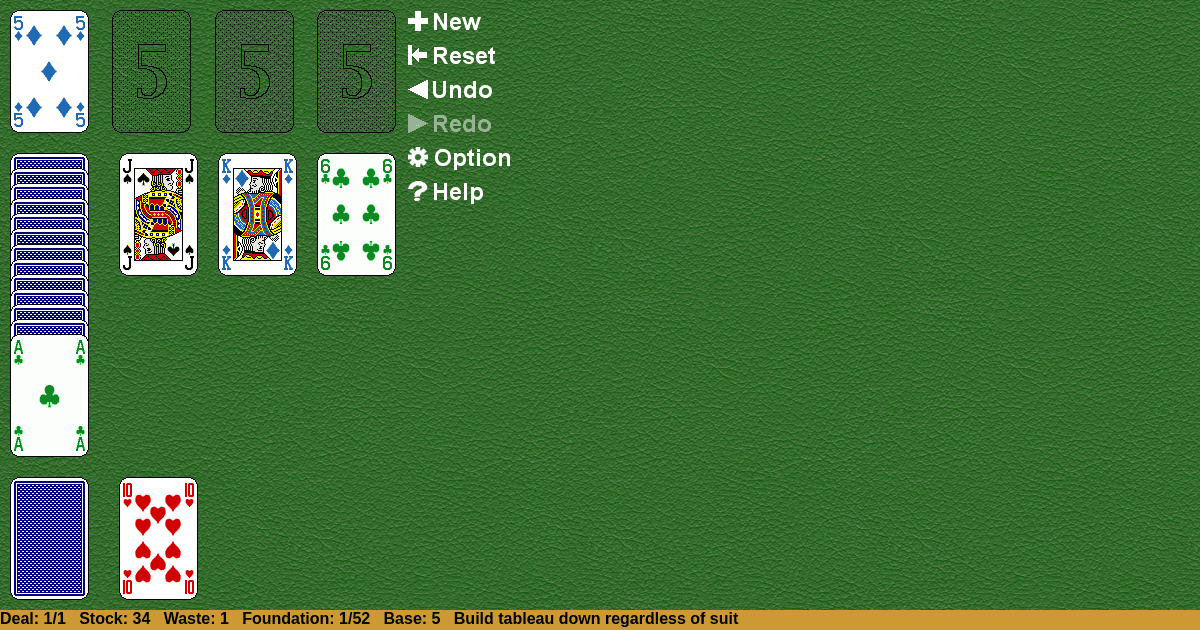Kansas
Home |
How to play |
FAQ |
About
How to play Kansas?
Game Objective:
The primary goal in Kansas Solitaire is to move all cards from the tableau, reserve, and waste piles to the foundation piles, constructing complete sequences by suit from Ace to King for each foundation.
Setup & Layout:
- Deck: Kansas Solitaire uses a standard 52-card deck.
- Foundations: Four foundation piles are created, each designed to build up by suit from Ace to King.
- Tableau: Three tableau piles are formed, each starting with one card dealt face-up.
- Reserve: One reserve pile is created, containing thirteen cards; the top card is face-up, and the remaining twelve are face-down.
- Stock: The remaining cards form the stock pile, which is used to introduce new cards into play.
- Waste: The waste pile starts empty and receives cards from the stock during gameplay.
Kansas Solitaire Rules:
Card Movement Principles:
- Foundations: Cards are built up by suit, starting from Ace and ending with King. An Ace may be placed on a King, allowing "around-the-corner" building.
- Tableau: Cards are built down in value, regardless of suit. For example, any 9 may be placed on any 10, regardless of suit.
- Reserve: Only the top face-up card is available to move into play.
- Waste: Only the top card is available for play.
Sequence Building:
- Tableau: Sequences built down (regardless of suit) may be moved together as a group.
- Foundations: Sequences are built up by suit. Wrapping from King to Ace is permitted.
Movement Between Areas:
- Cards and sequences may be moved from tableau to tableau, or from tableau/reserve/waste to the foundations, following the build rules above.
- Only valid sequences or single cards may be moved, adhering to the suit and value restrictions for each area.
Gameplay:
- Player Actions:
- Move available cards from tableau, reserve, or waste to the foundations if possible.
- Build tableau piles down by moving cards or sequences, regardless of suit.
- Move the top card of the reserve or waste to tableau or foundations as allowed.
- Move sequences built down in the tableau as a unit.
- Introducing New Cards:
- Tap the stock to deal one card face-up to the waste pile. Only one pass through the stock is allowed; there are no redeals.
- The top card of the waste becomes available for play.
- No Legal Moves:
- If no moves are possible, the game is blocked. The player may continue to deal from the stock until exhausted.
Winning & Losing Conditions:
- Winning: The game is won when all cards are successfully moved to the foundation piles, each containing a complete sequence from Ace to King by suit.
- Losing/Unwinnable State: The game is lost or becomes unwinnable if no legal moves remain and the stock is exhausted, leaving cards stranded in the tableau, reserve, or waste.
Special Rules & Edge Cases:
- Filling Empty Tableau Spaces: Empty tableau piles are automatically filled from the reserve pile (top card only). If the reserve is empty, any card or valid sequence may be moved to fill an empty tableau.
- Filling Empty Foundations: Empty foundation spaces may only be filled with the same rank as the initial card dealt to the first foundation at the start of the game.
- Reserve Pile: Once the reserve pile is empty, it remains empty for the rest of the game.
- Stock/Waste: Only a single pass through the stock is permitted. Once the stock is depleted, no further cards are introduced.
- Sequence Movement: Sequences built down in the tableau (regardless of suit) may be moved as a group, not just single cards.
- Around-the-Corner Building: Foundations permit wrapping from King back to Ace, allowing continuous building by suit.
Definitions:
- Foundation: Target piles built up by suit from Ace to King.
- Tableau: Primary play area where cards are built down, regardless of suit.
- Reserve: Auxiliary pile with limited access, providing additional cards.
- Stock: Undealt cards used to replenish the waste.
- Waste: Temporary holding area for cards dealt from the stock.
This guide provides a precise overview of Kansas Solitaire’s unique ruleset and gameplay mechanics, ensuring clarity for both new and experienced players.

Solitaire Collection
About Kansas
Rate (Kansas)
4.7 / 5
1,916 votes



























































